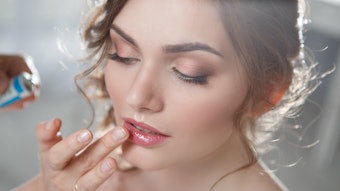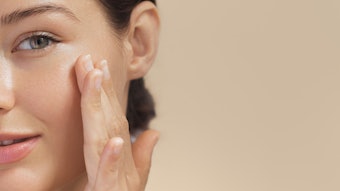
The sheer, flawless finish of airbrush makeup has made it the choice of television and film makeup artists for years, and it is now becoming an in-demand spa service—thanks in part to the popularity of high-definition photography, selfies and video. Clients appreciate the light, long-lasting coverage and the radiant, natural glow imparted to the skin, so it’s no surprise to see airbrush makeup in high demand for bridal services and graduation photographs. Skin care facilities can use this trend to set themselves apart from cosmetic counters to meet the personalized needs of their clients.
Why is airbrush makeup so special?
Airbrush makeup gives a polished look that can’t be achieved with regular makeup. This is because the particle size of the makeup that is applied through an air gun is so small that it produces a very thin, even layer of makeup that practically floats over skin instead of settling into fine lines, wrinkles and imperfections. When compared to non-airbrush foundations, the look of blemishes is significantly diminished because non-airbrush foundations can absorb into the skin and cause blemishes to stand out.
Airbrush makeup is composed of mainly water and mineral pigments, and comes in two basic formulas: water- and silicone-based. Water-based makeup uses finely ground pigments dissipated in water. It lets the skin breathe, is hypoallergenic and has a nonsticky feel. Silicone-based makeup is meant for long-lasting wear without fading. It’s popular because the silicones fill in skin imperfections, such as shallow scars, providing a more flawless appearance.
Airbrush makeup is nontransferable, meaning that slight rubbing or brushing against something or someone will not cause the makeup to be removed. Black clothes will remain black after hugging someone wearing airbrush makeup. It will only transfer to another surface if it gets wet—if the client should cry or sweat, she should simply blot instead of wiping to avoid the risk of smearing the makeup.
Using an air gun to apply makeup is also a healthy move. By using an air gun, the need for using fingers is eliminated, which has the potential of spreading bacteria and germs across the face.
Airbrush machine type and usage
There are many different machines out there to choose from. A great way to test them is to attend an industry trade show for hands-on experience. Machines differ on noise, compressor size, makeup formula, weight and the applicator wand.
There are two general types of airbrushes—dual-action and single-action—and they require slightly different techniques. A dual-action airbrush allows the user to control airflow, dictating the amount of makeup that is distributed. To use, the trigger is depressed with the index finger, drawing in air from the compressor. The further the trigger is depressed, the more makeup is released. The advantage of this is that the air can be used as a guide before allowing makeup to pass through the nozzle, giving the artist an exact idea of where the makeup will land on the face.
A single-action airbrush is generally considered easier to use because depressing the trigger releases a fixed ratio of makeup-to-air. However, in order to achieve different levels of coverage and detail, the nozzle has to be changed between applications, which can be quite cumbersome.
A professional airbrush makeup artist will work with a range up to 35 pounds per square inch (PSI). Many compressors designed for at-home use will not achieve airflow greater than 15 PSI. A low PSI is preferable when airbrushing makeup in trickier areas, such as the eyes, and is also ideal for sensitive skin because it uses less pressure. Fifteen PSI should be used when filling in eyebrows and applying eye shadow. Higher PSI is used when applying airbrush foundation, which creates a more continuous airflow and a faster application.
Color choice and application
One of the most important parts of airbrush makeup is choosing the foundation shade. With a full range of warm, neutral and cool foundations, everyone can have their perfect match. Airbrush makeup can be custom-blended right in the gravity feed of the gun to achieve the perfect color. Take time to ensure the foundation color matches the client’s skin perfectly. Until this is mastered, the color should be tested by dabbing it on a discreet spot on the client’s face to achieve a perfect match.
Airbrush makeup is great for creating facial dimension. There are two techniques for creating dimension: highlighting and contouring. Highlighting uses a color that is two shades lighter then the foundation and is applied above the cheekbone, below and above the brow, on the chin and on the middle of the nose. Highlighting lifts the face and draws attention to features. Pearly tones are perfect for this. To contour, first clean the cup after the last use and choose a shade two shades darker than the foundation. Apply it underneath the cheekbones and on features that need to be minimized, such as a wide forehead area or nose. When applying, lower the PSI to 12 to ensure not too much of the darker shade is released. See Application Considerations and Techniques.
Retail, at-home airbrushing
Today, the size of air compressors has decreased immensely, making at-home airbrushes more accessible. Yet, after using conventional makeup for years, clients might wonder why they should even consider investing in airbrush makeup for home use. The last thing a busy woman wants to worry about is her makeup. With airbrush makeup for home use, a client can apply her makeup in 10 minutes or less and achieve a celebrity-perfect airbrush finish that lasts all day long. Airbrush makeup is a complete solution to cover imperfections including acne, stretch marks, birthmarks, tattoos and scars. Lastly, you can encourage your clients to stay out of the sun and reduce their risk of cancer because they can use their at-home airbrush kit to bronze their face, neck, chest and legs within minutes.
There is a big opportunity to create additional retail sales with airbrush makeup. “Live on service—retire on retail” is not just a slogan; it’s a solution. The opportunity exists to make money on the in-spa airbrush service and back it up by becoming an airbrush retailer. Check to see if your chosen airbrush system offers airbrush makeup personal systems for clients, and learn how to best retail the system and refills in your spa.
Marketing airbrush makeup
Great ways to market this service include targeting brides, as well as young women who will be graduating soon and want to look great in their graduation photos. Run ads in bridal magazines, high school and college newspapers, and radio shows and social media, or partner with salons that do not offer makeup services. Use before-and-after pictures—they speak 1,000 words and will show off an artist’s talent.
Airbrush makeup is so versatile and allows a professional to offer clients flawless skin for weddings, everyday looks, photo shoots and even crazy Halloween makeup. Start practicing with airbrush makeup on friends and family and, before long, specialized airbrushing for holidays can be added to the service menu, increasing the bottom line and client base. Airbrushing makeup is a skill that most makeup artists and skin care professionals can learn, and that any skin care facility can add to its menu of services to catapult its business.
Jaclyn Peresetsky is CEO, esthetician and color specialist at SkinPerfect Image Wellness Spa in Columbus, Ohio. She is the author of Discover the Power of YOUR Colors (CreateSpace Independent Publishing Platform, 2013).










